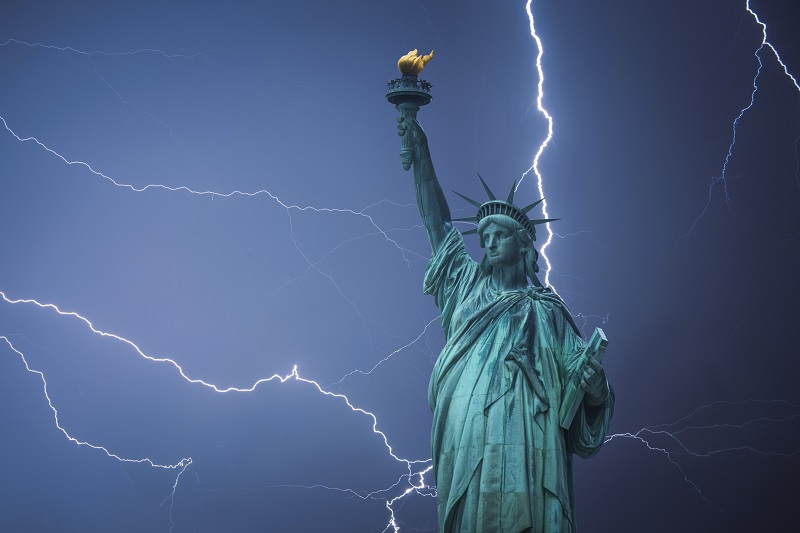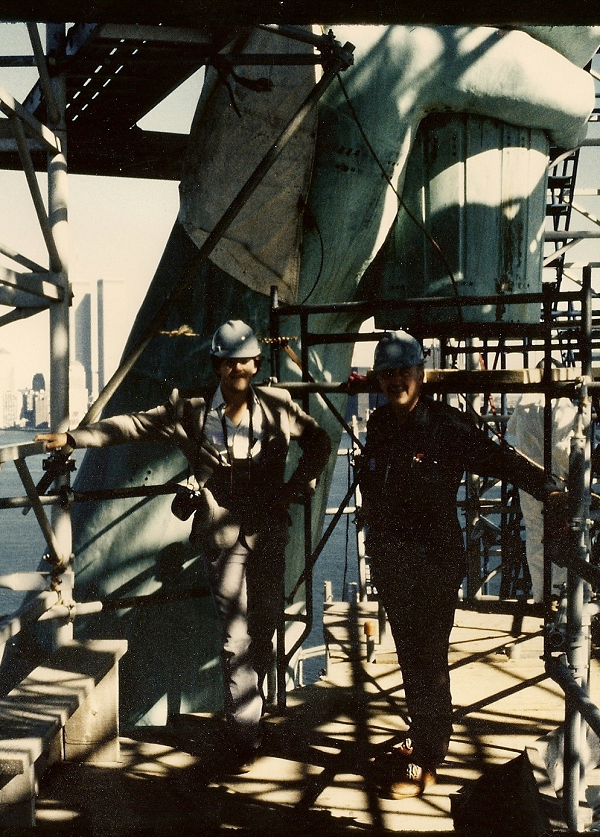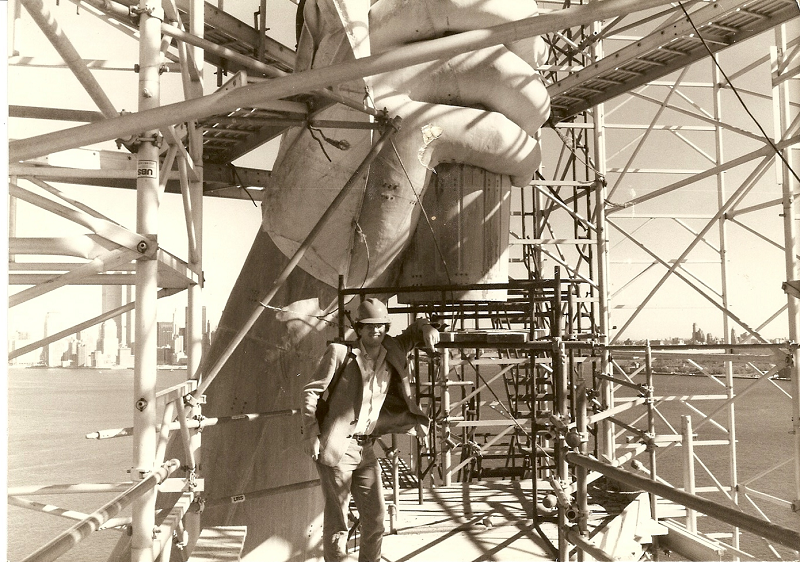
Lightning and Miss Liberty
Mike Violette
One hundred million volts, more or less. That is the potential that is developed during thunderstorms, as roiling masses of air and water and ice molecules swap electrons. Charge separation, caused by the friction in the air, related to the mechanism of static built up by rubbing balloon on cat, fills the atmosphere with pockets of ions–positive and negative. As the voltages build, the normally-insulating air molecules stress and disassociate and filaments of current crackle across the sky, releasing mega-joules of energy in each stroke. The supersonic expansion of the ionized air along the stroke path, boiled to a plasma, cracks in a sonic boom, rolling across the sky as thunder.
Upwelling currents of air lift charged particles, lofting them thousands of meters into the sky. Positively-charged ions congregate in the ground below, rushing to equalize the negative charges floating in the wind-whipped sky. At some point, the air fractures and an ionized channel opens between the Earth and Sky; a “stepped leader”—an opening parry—bridges the opposite charges with a flow of a few tens of amperes. Once the ionized channel is open, tens of thousands of amps or more rush to equalize the charge, dumping buckets of coulombs in the spasm, which may be repeated several times until all the charge is dissipated. The equalization temporarily sates the uneven voltage distribution, until further kinetic activity in the unstable air mass of the thunderstorm shakes loose another gazillion electrons and the process starts anew.
As there is no known method of preventing a lightning strike, management of lightning effects–shock, fire, structural damage–depends on understanding this key mechanism of charge equalization and the flow of currents during the few seconds of a lightning event. As all know, the best thing to do during a thunderstorm is to get out of the open and indoors. Who would know better about the hazards of standing out in the open during a thunderstorm with arm in the air than the Statue of Liberty, the gift of friendship from the people of France?
Standing tall in New York Harbor since 1886, the Statue of Liberty rises to a height of just over 300 feet–pedestal and all–her famous torch pointing East, welcoming the immigrants that make of the backbone of the United States. The half-million-pound copper and steel structure reportedly gets struck by lightning over 600 times in a year. During the restoration of 1984-1986, my father Norm Violette and I were involved in assessing the lightning protection of the famous monument. We had the opportunity to climb and crawl and inspect and make measurements and an assessment of her condition. Reporting to the general contractor, we composed a report and analysis of the lightning protection elements and made recommendations.
The key goal of the study was to understand how the statute has been affected by the six thousand or so lightning strikes over her (then) 100-year history as well as to look at the design of the protection system to safeguard people and the facility itself. This article is a summary of some of those findings.
Surface Inspection

First, we did a visual inspection of the entire structure taking the elevator to various points along the height of the statue. (The scaffolding was an engineering marvel in itself, rising from the pedestal to the torch without contacting the statue anywhere along its height.) The statue is made of hand-hammered sheets of copper—the thickness of 2 pennies.
“Attachment points”—where the lightning contacts the skin of the statue—were observed to be all along the height of the statue, on her shoulders and skirt and even on the tablet cradled in her left arm. Why would lightning strike at less-than-the-highest point? During a strike, lightning travels in short intervals of 50 to 100 meters or so, giving its characteristic jagged appearance. That means that, for tall structures, the tallest point may not be the most oft-struck. A mass of charge can build up in any direction and a lightning bolt may find its path to ground anywhere along the rise of a “tall” structure.
We found many quarter-sized abrasions on the surface of the statue, with only a small handful of actual punctures in the skin. The scorch-marks on the patina of the statue (the copper compounds that give the statue its characteristic aqua color) were thin and black and spattered. The patina is a fine insulator and the lightning currents punch through to the inner mass of conductor. Many of the scorch marks were weathered-over and fading and it was straightforward to guess which ones were “fresh”.
It was not a stretch to conclude that the skin of the Statue protects her just fine from lightning discharges. Our main focus was on what happens after the Statue gets hit.
Grounding and Bonding
As related in the short phenomenology introduction, the key to coping with a lightning strike is to equalize all charges as efficiently as possible. This is where Mother Earth comes in (in a cloud to ground strike, that is). It is important to have a low impedance path for the lightning currents to flow. Thick, wide short and direct conductors are the best, so the skin of the statue is ideal: monolithic plates of solid copper. The plates ride on Teflon-coated stainless-steel bars (the “armature) that was completely rebuilt during the reconstruction. The old system of support was of thick iron bars, hand-formed to match the curvature of the copper skin. During the restoration, each of these was removed, a drawing made and the part re-fitted with stainless steel.
Thus, the bulk of the statue proper is an excellent conductor and the flow of charge flows outward from the point of attachment. The impedance of the copper sheets is extremely low. We took a look under her skirt, so to speak, where the statue stands on her concrete pedestal.
We found four rods of solid copper, about 5/8” in diameter. They are bent to follow the curve of the drapes of her skirt and soldered for about 1 meter or so along the underside of the feet, placed approximately in each corner of the statue. At that point, the down conductors disappear into the top of the pedestal, which is a huge monolithic structure, composed of discrete 12” pours of concrete, stacked to a height of 300 feet.
To reach Mother Earth, the down-conductors connect to an unknown grounding structure. It is posited that a ring of copper was laid around the base during construction of the pedestal, but many of the drawings for the Statue disappeared during a fire at the turn of the century. In order to assess the condition of the grounding of the down-conductors, it was necessary to perform a ground resistance measurement.
Technical Stuff
The standard method for measuring ground resistance is to use the “fall of potential” method. To make this measurement, a three or four probe instrument (sometimes generically referred to as a “Megger”) is used to inject current into the ground and a voltmeter measures the induced potential. The resistance is inferred from Ohm’s law. We used this method to check the grounding resistance of the Statue earth electrode system as well as continuity of the down-conductors connected to the shell of the Statue.
The three-terminal fall of potential method is shown in Figure 1 (usually AC) current is injected between current electrodes E (the structure under test) and C, the current injection point. The voltage probe, P, measures the resultant voltage. Every grounding system has a “theoretical” ground resistance, which is the resistance between the ground system and infinitely-distant electrode. In practice a 30 to 50 meter spacing is sufficient, although it depends on the extent of the earth electrode system being measured. Figure 2 shows the behavior of the grounding resistance versus electrode spacing.
An AC current is used because in the vicinity of metallic structures, there are often galvanic currents that flow because of the cathode/anode behavior of buried metals (two dissimilar metals buried in ground act like a giant battery, essentially. These currents can incorrectly bias the measurements if a DC-based measurement is made.)
We found that the earth resistance was within acceptable levels—a few ohms. We also ran checks of the down-conductors using the same instrumentation. One out of the four copper cables showed a discontinuity, probably caused by a shift in the concrete; it was not possible to tell. Instead of trying to remedy the existing down-conductor, we specified the addition of a fourth conductor, using a stranded copper cable of the same diameter as the original. We ran the new down-conductor in an electrical chase, bonding the cable with the metal conduit at intervals of 10 meters or so.
A number of new metallic structures were installed in the pedestal, including staircases, structural equipment, HVAC, etc. These large metal objects, some stretching the several stories from the ground to the statue’s skirt, were incorporated into the lightning protection design.
During a lightning event, the current flowing to ground induces a potential due to the LdI/dt, where L is the self-inductance of the conductor and dI/dt on the order of 10,000+ Amperes per microsecond (Figure 3). The instantaneous voltage may “flash over” to nearby grounded objects due to the instantaneous potential difference.
Hence, we specified that all metallic structures be connected to the lightning protection down conductors at intervals of 10 meters. The benefits are several: in addition to reducing the likelihood of flashover, the net of the metal structures lowers the overall grounding impedance of the down-conductor system.

Figure 1 
Figure 2 
Figure 3
Torch
The torch was rebuilt by a band of metal artisans from France, in the true spirit of the original collaboration. The original torch was pretty messed up, having been modified in the early 1900s by Gutzom Bordlum (he of Mount Rushmore fame) who cut away much of the copper to install 250 panes of tinted glass. The idea was to light the structure from within. This compromised the water-tightness of the torch and over the years the elements leaked into the structure contributing to the deterioration.
The top of the torch was removed and hauled to Earth to be rebuilt at a workshop on site. A new torch was constructed from essentially the hilt upwards and covered with 24 karat gold leaf. The old torch rests in the visitor’s center. One of the concerns that the architects had was the preservation of the gold leaf over time. The gold leaf an excellent conductor, of course, was at the highest part of the Statute. It would undoubtedly absorb dozens of strikes a year. We suggested a pair of lightning rods to be installed at each end of the torch. The architects bristled and, in the end, aesthetics prevailed and no protection was installed.
Working on the Statue
The site visits that we took to New York Harbor are memorable. A small fleet of charted boats took workers to Liberty Island in shifts, leaving from Manhattan, Staten Island and New Jersey. From the nose of the Statue the Twin Towers could be seen dominating the skyline of lower Manhattan. Liberty Island was closed to the public and we got a first-hand lesson in New York City labor practices. The project employed workers in every industry: iron fitters, painters, laborers, longshoremen and carpenters and there was a certain amount of reverence about the site but sometimes daily realities caught up with workers. The Statue was accessed by an elevator that was integrated into the scaffolding. On one ride up the elevator, our operator—a grizzled union electrician sipping a cold beer (well, it was after 3 o’clock)—told us that the project management put up signs to tell workers not to relief themselves on the Statue because this was causing its own “patina.”

I haven’t returned to visit the Statue proper in these many years, but each time I visit New York City, I tried to catch a glimpse of “Liberty Enlightening the World.” It was an interesting and exciting project and much of the anecdotal information above was often related with enthusiasm—and a chuckle—by Dad. who loved lightning phenomenology and lightning protection as much as anyone I know and enjoyed telling people about our small contribution to an iconic monument to freedom.
Statue Fun Facts
- The sculpture was designed by Frédéric-Auguste Bartholdi, who was fascinated by oversized monuments and traveled to Egypt to tour the Sphinx and other grand monuments.
- The structure of the statue was designed by Gustave Eiffel, of Eiffel Tower Fame.
- The Statue was constructed at the workshops of Gadget, Gauhier, & Cie on the Rue de Chazelles in Paris. It was fully assembled in the courtyard and rose over the Parisian suburbs until it was disassembled, packed up and shipped to NY.
- In 1916 German Saboteurs allegedly blew up a munitions storage area due east of the Statue in Black Tom in New Jersey. The shock wave damaged the arm supports and the torch, which previously was open for visitors (via a ladder inside the arm) was closed.
- During the restoration, it was determined that the arm and head were misaligned during assembly in New York Harbor. The decision was made to build in reinforcement, rather that try to correct the errors as the main mission was preservation, not restoration. The misalignments caused structural weaknesses that compromised Eiffel’s original design.
First published in InCompliance Magazine September 1, 2010


